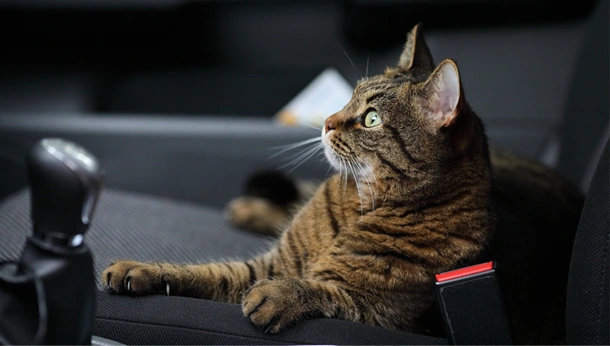Travelling with your dog can be a joy, especially when you reach your destination. Being able to travel with any pet is a necessity though, for visits to the vets or the groomers, and taking them to a pet sitter or boarding facility.
Are you wondering how to travel safely, or how to stop travel sickness in dogs, cats, and other pets? To support National Pet Month, which promotes responsible pet ownership, our Vet Alun Edwards has some helpful travel advice just in time for the summer holiday season.
Get our Pet Travel Sickness Guide
Ensuring an incident-free journey
Pet travel sickness and safety go hand in hand – making sure your pets feel safe in the car can help to reduce their anxiety and sickness. Motion sickness is more commonly seen in puppies and other young pets because their ear structures used for balance aren’t fully developed yet. Stress can also lead to travel sickness, which can affect all pets so if you only ever drive your pets to the vets to be poked and prodded (we offer other services too), anxiety may lead to nausea and vomiting.
Practising safe car travel will not only help to keep your pets safe, it will also help to keep you out of trouble with the law - letting your pets be a distraction whilst driving is a fineable offence. So, let’s dig in. Alun has listed some important pet travel safety advice to help you below, and you can download our handy Pet Travel Sickness Guide too.
Concerned about how sick your pet gets in the car? Contact our team for advice.
Cat & dog travel sickness symptoms and small furry stress
First, Alun advises pet owners to be aware of cat and dog travel sickness symptoms: inactivity (mostly dogs), yawning, whining/meowing, excessive drooling, vomiting, and smacking or licking lips. Stress in small furry pets presents in many ways including a reluctance to move, not eating or toileting, hiding, and aggression.

10 travel safety tips for pets
Alun shares their top tips for reducing the risk of accidents, injuries, stress, and a driving penalty with your pet in the car:
- Never let your pet travel in the front passenger seat as they could be seriously injured if the airbag releases.
- Secure dogs on your back seat with a seatbelt and harness, or in a dog crate on the back seat or in the boot. If using a seatbelt, never clip it to your dog’s collar, and consider using a dog travel seat that keeps your dog contained and stops them from slipping into the footwell.
- Secure cats & small furries in a secure cat or small pet carrier either on the back seat (with a seat belt if possible) or in a footwell. A small pet carrier must have air holes, and it is advisable to add a deep bed of hay plus a shelter to hide in. Put some cucumber (or moist veggies) in with small furries so they have a water source on the journey.
- Lie crates and carriers as flat as possible and put comfortable bedding in them.
- Make sure nothing can fall on your pet or cause them harm i.e. avoid piling up suitcases, bags, tools, or other items next to them and keep food out of their reach.
- Reduce stress and avoid fighting by never putting pets in the same crate or carrier – pet fights whilst driving can be very dangerous for your pets, you, and other drivers. Plus, if you have an accident, your pets may bang into each other and cause further injury.
- In warm weather, use sunshades on your windows, try to avoid travelling at the hottest times of the day and long journeys, and never leave your pet in a parked car.
- Always take water and a bowl with you on car journeys and take regular breaks to check your pet is ok – avoid using cooling coats as these can dry out and trap the heat in.
- Reduce other distractions in the car such as music, so you can focus on driving first and foremost, and can hear anything concerning that you need to park up and address.
- Take extra care with speed, speed bumps, and sudden stops or turns to avoid your pet being thrown around in the car.
So, there you have it – ten excellent pieces of advice to help you ensure a safe journey for you and your pets. When it comes to the dreaded travel sickness – you can get our tips for reducing this here in our handy guide:
Download our Pet Travel Sickness Guide
If your pet has severe travel sickness and nothing seems to relieve this, bring your pet to see Alun or any of our Vets for advice – get in touch